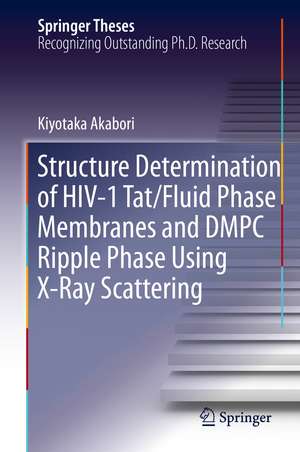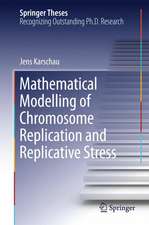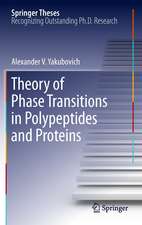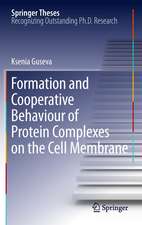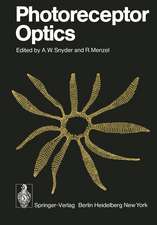Structure Determination of HIV-1 Tat/Fluid Phase Membranes and DMPC Ripple Phase Using X-Ray Scattering: Springer Theses
Autor Kiyotaka Akaborien Limba Engleză Hardback – 30 oct 2015
The first part focuses on the interaction between a short 11-mer peptide, Tat, which is part of the Tat protein in the HIV-1 virus. Although highly positively charged, the Tat protein has been shown to translocate through hydrocarbon lipid bilayers easily, without requiring the cell’s energy, which is counter to its Born self-energy. In this work Tat’s location in the headgroup region was demonstrated using a combined X-ray scattering and molecular dynamics approach. Bilayer thinning was observed as well as softening of different membrane mimics due to Tat. It was concluded that Tat’s headgroup location, which increases the area/lipid, and its bilayer softening likely reduce the energy barrier for passive translocation.
The second part is a rigorous investigation of an enigmatic phase in the phase diagram of the lipid dimyristoylphosphatidylcholine (DMPC). The ripple phase has fascinated many researchers in condensed matter physics and physical chemistry as an example of periodically modulated phases, with many theoretical and simulation papers published. Despite systematic studies over the past three decades, molecular details of the structure were still lacking. By obtaining the highest resolution X-ray data so far, this work revealed the complex nature of the chain packing, as well as confirming that the major side is thicker than the minor side of the saw-tooth ripple structure. The new model shows that the chains in the major arm are tilted with respect to the bilayer normal and that the chains in the minor arm are slightly more disordered than all-trans gel-phase chains, i.e., the chains in the minor arm are more fluid-like. This work provides the highest resolution X-ray structure of the ripple phase to-date.
| Toate formatele și edițiile | Preț | Express |
|---|---|---|
| Paperback (1) | 381.98 lei 6-8 săpt. | |
| Springer International Publishing – 23 aug 2016 | 381.98 lei 6-8 săpt. | |
| Hardback (1) | 389.31 lei 6-8 săpt. | |
| Springer International Publishing – 30 oct 2015 | 389.31 lei 6-8 săpt. |
Din seria Springer Theses
- 18%
 Preț: 997.88 lei
Preț: 997.88 lei -
 Preț: 389.88 lei
Preț: 389.88 lei - 15%
 Preț: 646.94 lei
Preț: 646.94 lei - 18%
 Preț: 943.43 lei
Preț: 943.43 lei -
 Preț: 399.29 lei
Preț: 399.29 lei - 18%
 Preț: 944.99 lei
Preț: 944.99 lei - 15%
 Preț: 636.80 lei
Preț: 636.80 lei - 18%
 Preț: 941.05 lei
Preț: 941.05 lei - 15%
 Preț: 643.16 lei
Preț: 643.16 lei - 15%
 Preț: 642.68 lei
Preț: 642.68 lei - 18%
 Preț: 1103.62 lei
Preț: 1103.62 lei - 20%
 Preț: 558.83 lei
Preț: 558.83 lei - 18%
 Preț: 1112.30 lei
Preț: 1112.30 lei - 18%
 Preț: 944.19 lei
Preț: 944.19 lei - 18%
 Preț: 1109.92 lei
Preț: 1109.92 lei - 18%
 Preț: 1217.27 lei
Preț: 1217.27 lei - 15%
 Preț: 640.06 lei
Preț: 640.06 lei - 15%
 Preț: 636.45 lei
Preț: 636.45 lei - 15%
 Preț: 640.06 lei
Preț: 640.06 lei - 15%
 Preț: 640.88 lei
Preț: 640.88 lei -
 Preț: 389.70 lei
Preț: 389.70 lei - 20%
 Preț: 563.91 lei
Preț: 563.91 lei -
 Preț: 393.35 lei
Preț: 393.35 lei - 15%
 Preț: 637.93 lei
Preț: 637.93 lei - 15%
 Preț: 641.85 lei
Preț: 641.85 lei - 18%
 Preț: 1225.94 lei
Preț: 1225.94 lei - 20%
 Preț: 551.36 lei
Preț: 551.36 lei - 18%
 Preț: 1229.10 lei
Preț: 1229.10 lei - 15%
 Preț: 639.25 lei
Preț: 639.25 lei - 18%
 Preț: 999.45 lei
Preț: 999.45 lei - 15%
 Preț: 640.06 lei
Preț: 640.06 lei - 18%
 Preț: 1220.45 lei
Preț: 1220.45 lei - 18%
 Preț: 1116.26 lei
Preț: 1116.26 lei - 18%
 Preț: 1110.72 lei
Preț: 1110.72 lei - 18%
 Preț: 1000.87 lei
Preț: 1000.87 lei - 18%
 Preț: 891.17 lei
Preț: 891.17 lei - 15%
 Preț: 640.06 lei
Preț: 640.06 lei - 5%
 Preț: 1154.07 lei
Preț: 1154.07 lei - 15%
 Preț: 635.96 lei
Preț: 635.96 lei - 15%
 Preț: 640.88 lei
Preț: 640.88 lei -
 Preț: 387.20 lei
Preț: 387.20 lei - 18%
 Preț: 1109.92 lei
Preț: 1109.92 lei -
 Preț: 385.25 lei
Preț: 385.25 lei -
 Preț: 385.25 lei
Preț: 385.25 lei - 18%
 Preț: 1112.30 lei
Preț: 1112.30 lei - 18%
 Preț: 999.45 lei
Preț: 999.45 lei -
 Preț: 386.99 lei
Preț: 386.99 lei - 15%
 Preț: 637.13 lei
Preț: 637.13 lei - 20%
 Preț: 554.21 lei
Preț: 554.21 lei - 20%
 Preț: 555.59 lei
Preț: 555.59 lei
Preț: 389.31 lei
Nou
Puncte Express: 584
Preț estimativ în valută:
74.50€ • 79.66$ • 62.11£
74.50€ • 79.66$ • 62.11£
Carte tipărită la comandă
Livrare economică 18 aprilie-02 mai
Preluare comenzi: 021 569.72.76
Specificații
ISBN-13: 9783319222097
ISBN-10: 3319222090
Pagini: 220
Ilustrații: XX, 168 p.
Dimensiuni: 155 x 235 x 17 mm
Greutate: 0.45 kg
Ediția:1st ed. 2015
Editura: Springer International Publishing
Colecția Springer
Seria Springer Theses
Locul publicării:Cham, Switzerland
ISBN-10: 3319222090
Pagini: 220
Ilustrații: XX, 168 p.
Dimensiuni: 155 x 235 x 17 mm
Greutate: 0.45 kg
Ediția:1st ed. 2015
Editura: Springer International Publishing
Colecția Springer
Seria Springer Theses
Locul publicării:Cham, Switzerland
Public țintă
ResearchCuprins
Introduction.- Lipid bilayers.- Tat peptide.- Pb¢ ripple phase.- Structural and Material Perturbations of Lipid Bilayers Due to HIV-1 Tat Peptide.- Introduction.- Materials and Methods.- Analysis of Molecular Dynamics Simulation Data.- Results.- Discussion.- Conclusions.- Ripple Phase.- Introduction.- Materials and Methods.- LAXS Data Reduction.- Results for Fhk Form Factors.- Models to Fit the Fhk and Obtain the Phase Factors.- Electron Density Profiles and Coarse Grained Bilayer Structure.- nGIWAXS: Results.- tWAXS: Results.- Thin Rod Model.- Combining WAXS and LAXS Results for the Major Arm.- Discussion.- Conclusion.- Appendices.
Textul de pe ultima copertă
This Thesis in biological physics has two components, describing the use of X-ray scattering techniques to study the structure of two different stacked lipid membrane systems.
The first part focuses on the interaction between a short 11-mer peptide, Tat, which is part of the Tat protein in the HIV-1 virus. Although highly positively charged, the Tat protein has been shown to translocate through hydrocarbon lipid bilayers easily, without requiring the cell’s energy, which is counter to its Born self-energy. In this work Tat’s location in the headgroup region was demonstrated using a combined X-ray scattering and molecular dynamics approach. Bilayer thinning was observed as well as softening of different membrane mimics due to Tat. It was concluded that Tat’s headgroup location, which increases the area/lipid, and its bilayer softening likely reduce the energy barrier for passive translocation.
The second part is a rigorous investigation of an enigmatic phase in the phase diagram of the lipid dimyristoylphosphatidylcholine (DMPC). The ripple phase has fascinated many researchers in condensed matter physics and physical chemistry as an example of periodically modulated phases, with many theoretical and simulation papers published. Despite systematic studies over the past three decades, molecular details of the structure were still lacking. By obtaining the highest resolution X-ray data so far, this work revealed the complex nature of the chain packing, as well as confirming that the major side is thicker than the minor side of the saw-tooth ripple structure. The new model shows that the chains in the major arm are tilted with respect to the bilayer normal and that the chains in the minor arm are slightly more disordered than all-trans gel-phase chains, i.e., the chains in the minor arm are more fluid-like. This work provides the highest resolution X-ray structure of the ripple phase to-date.
The first part focuses on the interaction between a short 11-mer peptide, Tat, which is part of the Tat protein in the HIV-1 virus. Although highly positively charged, the Tat protein has been shown to translocate through hydrocarbon lipid bilayers easily, without requiring the cell’s energy, which is counter to its Born self-energy. In this work Tat’s location in the headgroup region was demonstrated using a combined X-ray scattering and molecular dynamics approach. Bilayer thinning was observed as well as softening of different membrane mimics due to Tat. It was concluded that Tat’s headgroup location, which increases the area/lipid, and its bilayer softening likely reduce the energy barrier for passive translocation.
The second part is a rigorous investigation of an enigmatic phase in the phase diagram of the lipid dimyristoylphosphatidylcholine (DMPC). The ripple phase has fascinated many researchers in condensed matter physics and physical chemistry as an example of periodically modulated phases, with many theoretical and simulation papers published. Despite systematic studies over the past three decades, molecular details of the structure were still lacking. By obtaining the highest resolution X-ray data so far, this work revealed the complex nature of the chain packing, as well as confirming that the major side is thicker than the minor side of the saw-tooth ripple structure. The new model shows that the chains in the major arm are tilted with respect to the bilayer normal and that the chains in the minor arm are slightly more disordered than all-trans gel-phase chains, i.e., the chains in the minor arm are more fluid-like. This work provides the highest resolution X-ray structure of the ripple phase to-date.
Caracteristici
Nominated by Carnegie Mellon University as an outstanding PhD Thesis Describes the use of X-ray scattering techniques to study the structure of two different stacked lipid membrane systems Presents the highest resolution X-ray structure of the DMPC ripple phase to-date
